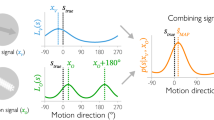Abstract
We report on the sensitivity of human observers with respect to the detection of transients in otherwise uniformly moving two-dimensional random-dot patterns. The target field is divided into two halfs that each contains a moving random-dot pattern. The patterns in the two halffields are mutually uncorrelated. Parameters are the average velocity and the difference-velocity for the two halfs. These velocities are both vectors that can be varied in magnitude and in their direction with respect to the border of the two halffields. In order to quantify the sensitivity of the visual system to such patterns, we added (linear addition) spatio-temporal white noise (“snow”) to the pattern. Then the sensitivity is quantified by way of the threshold signal-to-noise ratio necessary to discriminate the composite pattern from a single smoothly uniformly moving pattern. The signal-to-noise ratio specifies the square of the ratio between the signal r.m.s. contrast and the r.m.s. contrast of the masking stimulus (spatio-temporal white noise or “snow”). The r.m.s. contrast of the complex pattern (signal and noise) is kept invariant. We find that the detection performance is independent of the direction of either the average or difference-velocity with respect to the border, and can be completely described in terms of a minimum requirement for the magnitude of the difference-velocity. The magnitude of the difference-velocity must exceed the magnitude of the average velocity in order to lead to a perceivable transient. In his formulation the Weberlaw for the detection of velocity transients in uniformly moving noise patterns is applicable to both differences in magnitude and direction of the velocities.
Similar content being viewed by others
References
Doorn, A.J. van, Koenderink, J.J.: Temporal properties of the visual detectability of moving spatial white noise. Exp. Brain Res. 45, 179–188 (1982a)
Doorn, A.J. van, Koenderink, J.J.: Spatial properties of the visual detectability of moving spatial white noise. Exp. Brain Res. 45, 189–195 (1982b)
Gibson, J.J.: The perception of the visual world. Cambridge, Mass.: Houghton Mifflin Company, Boston, Riverside Press 1950
Helmholtz, H. von: Helmholtz's treatise on physiological optics. Southall, J.P.C. (ed.) Opt. Soc. Am. New York (1925)
Koenderink, J.J., Doorn, A.J. van. Invariant properties of the motion parallax field due to the movement of rigid bodies relative to an observer. Optica Acta 22, 773–791 (1975)
Nakayama, K., Loomis J.M.: Optical velocity patterns, velocity-sensitive neurons, and space perception: a hypothesis. Perception 3, 63–80 (1974)
Poggio, T., Reichardt, W., Hausen, K.: A neuronal circuitry for relative movement discrimination by the visual system of the fly. Naturwissenschaften 68, 443–446 (1981)
Regan, D., Beverley, K.I.: Looming detectors in the human visual pathway. Vision Res. 18, 415–421 (1978)
Rogers, B., Graham, M.: Motion parallax as an independent cue for depth perception. Perception 8, 125–134 (1979)
Author information
Authors and Affiliations
Rights and permissions
About this article
Cite this article
van Doorn, A.J., Koenderink, J.J. Visibility of movement gradients. Biol. Cybern. 44, 167–175 (1982). https://doi.org/10.1007/BF00344272
Received:
Issue Date:
DOI: https://doi.org/10.1007/BF00344272




